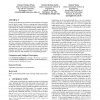Free Online Productivity Tools
i2Speak
i2Symbol
i2OCR
iTex2Img
iWeb2Print
iWeb2Shot
i2Type
iPdf2Split
iPdf2Merge
i2Bopomofo
i2Arabic
i2Style
i2Image
i2PDF
iLatex2Rtf
Sci2ools
113
Voted
ATAL
2011
Springer
2011
Springer
Learning action models for multi-agent planning
In multi-agent planning environments, action models for each agent must be given as input. However, creating such action models by hand is difficult and time-consuming, because it requires formally representing the complex relationships among different objects in the environment. The problem is compounded in multi-agent environments where agents can take more types of actions. In this paper, we present an algorithm to learn action models for multi-agent planning systems from a set of input plan traces. Our learning algorithm Lammas automatically generates three kinds of constraints: (1) constraints on the interactions between agents, (2) constraints on the correctness of the action models for each individual agent, and (3) constraints on actions themselves. Lammas attempts to satisfy these constraints simultaneously using a weighted maximum satisfiability model known as MAX-SAT, and converts the solution into action models. We believe this to be one of the first learning algorithms...
Related Content
| Added | 12 Dec 2011 |
| Updated | 12 Dec 2011 |
| Type | Journal |
| Year | 2011 |
| Where | ATAL |
| Authors | Hankz Hankui Zhuo, Hector Muñoz-Avila, Qiang Yang |
Comments (0)

